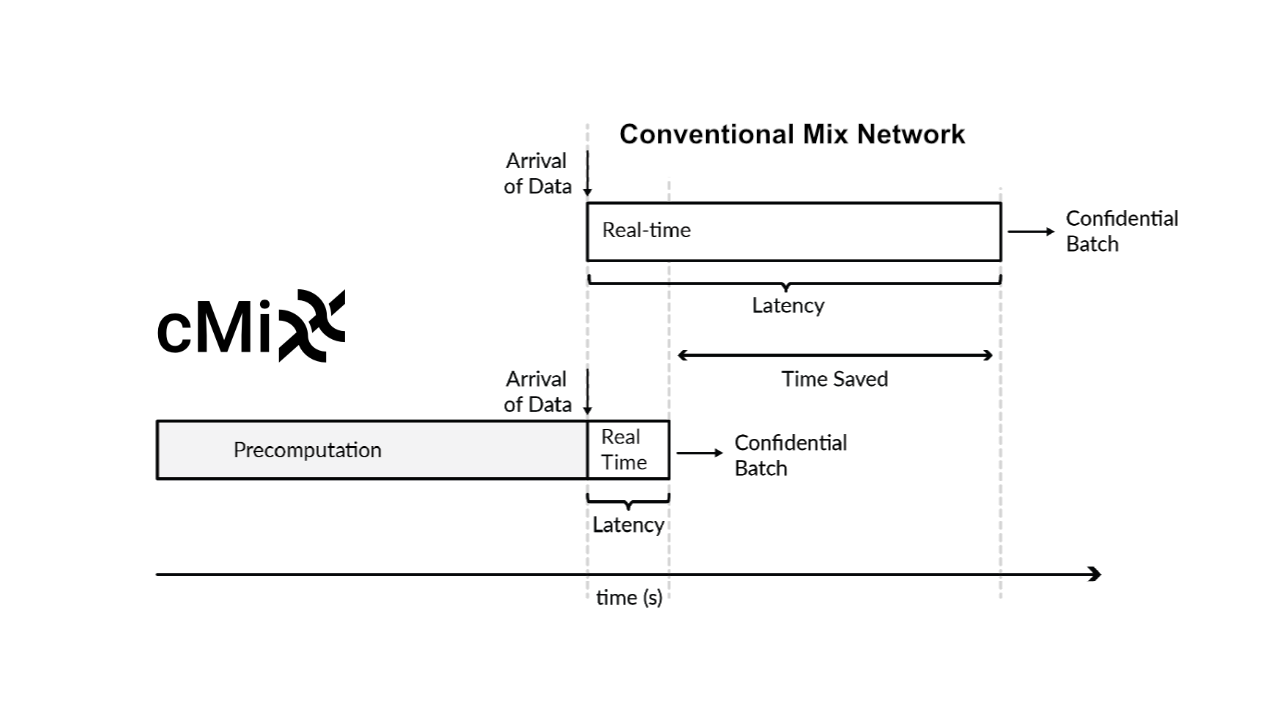In 2016, Chaum and a team of researchers published a design for an “accelerated” mix net called “cmix”. “Precomputation” was proposed as the solution to the slowness of typical mix nets.
Precomputation allows mix nodes to execute the time-consuming public key cryptography before the real-time phase of handling messages or data transmission between senders and recipients. The result is a very efficient type of mixnet that allows users to send and receive in real-time without compromising security or privacy.
Part of the initial research project was an academic reference implementation that served as a proof of concept for cmix; it included a backend team of mix nodes and a rudimentary smartphone client.
In August 2017, under Chaum’s leadership, a development group began creating a decentralized, secure and scalable implementation called cMixx. The team included pioneers who developed early practical, anonymous, and verifiable cryptographic systems. Its members were among the first to propose and deploy digital currencies, mix networks, un-permissioned cryptography, verifiable voting systems, and many other advances in cryptography.
cMixx is a very fast mixnet. More generally, mixnets, also known as mixing networks, were first described by xx network Founder David Chaum in 1979. A mixnet lays down cryptographic rules for messages or transactions to be relayed by a sequence of trusted intermediaries known as mix nodes. These mix nodes receive a batch of encrypted pieces of data from users, randomly permute or “mix” them, and then send the reordered, encrypted data forward to the next mix node.
This “mixing” obscures the metadata associated with user activity, creating a privacy-protecting communication system. Metadata is the who,what, when, where, and how details associated with any message or activity.
The main drawback to existing mixnets is that the public key operations necessary for the mixing operation require intensive computing. In fact, in 1979, the computations originally described in Chaum’s paper exceeded the power of most existing computers. Even now, the required computation for typical mixnets is resource intensive and time-consuming. As a result, when performed at scale, mixnets are too slow for most consumer uses.
cMixx is the xx network’s advanced privacy protocol designed to eliminate metadata exposure in online interactions among people, chains, and businesses.
In precomputation, after a new team of xx nodes is randomly selected, the nodes undertake a series of quantum resistant cryptographic computations to produce a template that dictates how the team must process information during mixing. The template is completely defined before the batch of messages arrives, ensuring confidentiality while dramatically increasing the speed at which information can be processed in the real time phase.

In real-time, senders query gateways and then send their data. Gateways then aggregate the data in anonymity sets. The network routes the data sets through a randomly selected team of nodes. The first team node uses the template to effectively encrypt each piece of data; the node also uses the template to change the order of data in the set. Successive team nodes repeat this process. The last node sends the anonymity set, of now encrypted data, out to a gateway. Recipients then query xx gateways to retrieve their data.
Unlike existing data transfer and communication software using legacy cryptography, cMixx is quantum-resistant, safeguarding data and content even against future quantum computing threats.
The xx network’s “mixing” process breaks the link between senders and recipients, guaranteeing total anonymity and making it impossible to track interaction patterns or identify users. Unlike traditional communication or data transfer methods that expose metadata such as IP addresses and timestamps, cMixx effectively encrypts and randomizes data traffic, preventing any form of tracing. This level of privacy is crucial for securing sensitive data.
The protocol can be seamlessly integrated as a Layer-2 privacy solution across various blockchain networks, enhancing security for decentralized applications, businesses, and other digital services. With cMixx, the xx network is building the infrastructure for secure, private, and scalable communication in the digital age.
xx network does not distribute, offer, solicit sales of, or sell any xx coins in any state or jurisdiction in which such a distribution, offer, solicitation or sale would be unlawful prior to registration or qualification under the securities laws of any such state or jurisdiction.
Copyright © 2025 xx Foundation